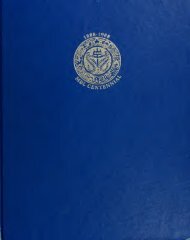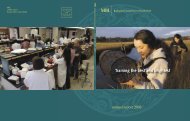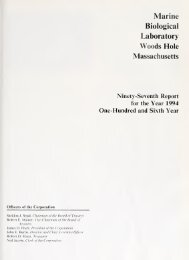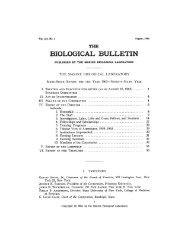- Page 5:
GENERAL EMBRYOLOGICAL IMFORMATION S
- Page 9:
CONTENTS a) Introduction p. 5 b) Li
- Page 13 and 14:
LIST OF NAMES AND ADDRESSES with Su
- Page 15 and 16:
. Physical changes at fertilization
- Page 17 and 18:
ASHLEY, G. T. B.Sc, Ch.B., M.D. —
- Page 19 and 20:
a. Investigations of experimentally
- Page 21 and 22:
c. Fruchthtillenmotorik und Motorik
- Page 23 and 24:
BENAZZI, M. M.I.I.E., Prof.ord. —
- Page 25 and 26:
. Autoradiografische Untersuchungen
- Page 27 and 28:
BONDI, C. Dott., Prof. — 1st. di
- Page 29 and 30:
BRADEN, A. W. H. M.Sc, Ph.D. — Di
- Page 31 and 32:
BUCHANAN. G. D. B.A., M.A., Ph.D.
- Page 33 and 34:
CAMPENHOUT, E. van Dr., F.I. I.E.,
- Page 35 and 36:
a. Congenital malformations due to
- Page 37 and 38:
a. Gametogenesis. (Arthropoda) b. D
- Page 39 and 40:
. Culture d'organes embryonnaires s
- Page 41 and 42:
c. Lunar periodicity of spawning. C
- Page 43 and 44:
DETH, J. H. M. van M.D., Prof. —
- Page 45 and 46:
. Source of lens proteins in lens r
- Page 47 and 48:
a. Development of collagenous lamel
- Page 49 and 50:
a. Histochemistry and submicroscopi
- Page 51 and 52:
c. Comparison between the ontogenie
- Page 53 and 54:
FREEMAN, Miss G. — Dept. of Anat.
- Page 55 and 56:
. Recherches experimentales sur la
- Page 57 and 58:
e. Differenciation de l'epiderme. M
- Page 59 and 60:
GOUBE de LAFOREST, P. Dr. en Med.
- Page 61 and 62:
a. Relationships between physiologi
- Page 63 and 64:
c. Effects of rare earth ions on de
- Page 65 and 66:
HARRISON, R. J. M.A., D.Sc, M.D.
- Page 67 and 68:
HEMPEL, G. Dr. — Inst, fur Fische
- Page 69 and 70:
HISHIDA, T. M.A. — Biol. Inst., F
- Page 71 and 72:
HUBER, W. D.Sc. — Museum d'Histoi
- Page 73 and 74:
INOUE. S. — Inst, of Endocrinol.,
- Page 75 and 76:
a. Embryology. Sardinops ocellata,
- Page 77 and 78:
a. Morphogenesis of notochord in ea
- Page 79 and 80:
KATO, M. D.Sc. — Lab. of Embryol.
- Page 81 and 82:
KING, Th. J. B.S., M.S., Ph.D., M.I
- Page 83 and 84:
d. Identifizierung von Melanoblaste
- Page 85 and 86:
KUHN, O. Dr.rer.nat., Prof. — Zoo
- Page 87 and 88:
LAZARD (HAUBEN), Mrs. L. Lie. es Sc
- Page 89 and 90:
LEROY, P. J. M. Dr. es Sci. — Lab
- Page 91 and 92:
LOUVET, J. -P. Lie. es Sci. — Lab
- Page 93 and 94:
MAGGIO, Miss R. Ph.D. — 1st. di A
- Page 95 and 96:
a. Induction of premature cleavage
- Page 97 and 98:
a. Transplantation of tumor (Lucke
- Page 99 and 100:
c. Experimental analysis of the dev
- Page 101 and 102:
MOLINARO, M. Dr. — 1st. di Zool.,
- Page 103 and 104:
MOSSMAN, H. W. B.S., M.S., Ph.D., M
- Page 105 and 106:
. Study of development in the prese
- Page 107 and 108:
]. Coelomic studies of differentiat
- Page 109 and 110:
c. Effects of light on spermatozoa.
- Page 111 and 112:
. Study of spicule formation by iso
- Page 113 and 114:
a. Biochemical and immunochemical s
- Page 115 and 116:
PETERS, Th. Dr.Med. — Anat. Inst,
- Page 117 and 118:
. Regenerative capacity and immunit
- Page 119 and 120:
a. Development and cytology. (Tricl
- Page 121 and 122:
a. Sperm enzyme activity. Mellita q
- Page 123 and 124:
ROBERTSON, G. G. B.A., B.Sc, Ph.D.,
- Page 125 and 126:
ROUX, Ch. Dr. en Med. — Lab. d'Em
- Page 127 and 128:
. Cell division in tissue cultures
- Page 129 and 130:
c. Ectoderm-mesoderm interactions i
- Page 131 and 132:
a. Analyse experimental de la cepha
- Page 133 and 134:
. Normal and abnormal development o
- Page 135 and 136:
e. Development of head structure wi
- Page 137 and 138:
a. Development of the sympatho-adre
- Page 139 and 140:
. STAGNI. Miss A. Dr. — 1st. di Z
- Page 141 and 142:
STEPHENSON, N. G. M.Sc, Ph.D. — D
- Page 143 and 144:
SWARTZ. G. E. B.A., M.A., Ph.D. —
- Page 145 and 146:
TARTAR. V. B.S., M.S., Ph.D. — De
- Page 147 and 148:
a. Isolierung und chemische Charakt
- Page 149 and 150:
c. Influence des hormones sur le de
- Page 151 and 152:
a. Experimental production of conge
- Page 153 and 154:
WAELSCH, Mrs. S. GLUECKSOHN Ph.D.,
- Page 155 and 156:
W^GLARSKA, Miss B. D.Sc. — Zool.
- Page 157 and 158:
c Morphology and causal biochemistr
- Page 159 and 160:
d. Recherches sur la differenciatio
- Page 161 and 162:
a. Cytochemical investigation on de
- Page 163 and 164:
ZOTIN, A. I. Cand.Biol.Sci. — Ins
- Page 165 and 166:
Sudan U.S.A. (Ala.; TOIT, C. A. du
- Page 167 and 168:
U.S.A. (D.C.) U.S.A. (111.) * COUNC
- Page 169 and 170:
U.S.A. (Me.) REAMS, W. M. Jr. Asst.
- Page 171 and 172:
U.S.A. (Miss.) MISSISSIPPI (Miss.)
- Page 173 and 174:
U.S.A. (N.C.) * ARMSTRONG, P. B. Pr
- Page 175 and 176:
U.S.A. (Vt.) Galveston, Univ. of Te
- Page 177 and 178:
Indonesia Calcutta 12, College Stre
- Page 179 and 180:
Japan Inst, of Endocrinol. HANAOKA,
- Page 181 and 182:
Australia (N.S.W.) ERENQIN, Z. Prof
- Page 183 and 184:
Denmark Plzeri, Karlovarska 48, Cha
- Page 185 and 186:
France * SIGOT (LUIZARD).Mrs. M. F.
- Page 187 and 188:
Germany (W.) BUTSCHAK, G. Gatersleb
- Page 189 and 190:
Hungary HUNGARY Budapest IX, Tuzolt
- Page 191 and 192:
Netherlands MILANO, E. Asst. Roma,
- Page 193 and 194:
Portugal Polish Acad, of Sci., Dept
- Page 195 and 196:
Switzerland * GYLLENSTEN, L. J. W.
- Page 197 and 198:
U.K. (England) London, S.W. 7, Brit
- Page 199 and 200:
U.S.S.R. U.S.S.R. Leningrad B-164,
- Page 201 and 202:
Key to organ systems and organs: CH
- Page 203 and 204:
CHORDATA a general subjects b kidne
- Page 205 and 206:
I. 1 2 Development of neural crest
- Page 207 and 208:
I. 6a I. 6d 6 Further development o
- Page 209 and 210:
I. 7b I. 7c Salfi, M — a
- Page 211 and 212:
I. 7c. 3 I.7e. 4 Assenmacher, LA.
- Page 213 and 214:
I. 7e. 7 a Pera, L. — b Jit, I.
- Page 215 and 216:
a b I. 8c I 8d c Differentiation d
- Page 217 and 218:
II. 4a Vannini, E. — b Harvey, E.
- Page 219 and 220: II. 6e. 1 Extremities Haget. A. —
- Page 221 and 222: II. 7c Nakamura, I. — a L Nebel.L
- Page 223 and 224: II. 7e. 3 II 7e. 3 Notarnicola, L.
- Page 225 and 226: II. 7e. 9 Rychter, Z. — a Roberts
- Page 227 and 228: II. 8c bab bd ab c Differentiation
- Page 229 and 230: III. 1 4 Organization d Development
- Page 231 and 232: III. 4f b b b ba a Hori, R. — (7)
- Page 233 and 234: III. 6b Schmidt. G. A. — b Chaign
- Page 235 and 236: III. 7a Wallace, H. — a
- Page 237 and 238: III. 7c III. 7d Badinez, O. — a
- Page 239 and 240: III. 7e. 3 Hypophysis (see also und
- Page 241 and 242: III. 7e. 11 (7)M Clark. H. — d St
- Page 243 and 244: III. 8d III. 9 Wilde. C. E., Jr.
- Page 245 and 246: IV. 2d Hamilton, L. — b Kawamura,
- Page 247 and 248: V. 1 V. 2c b Abnormal development o
- Page 249 and 250: V. 3 3 Abnormal early development a
- Page 251 and 252: VI. 1 VI. 5 4 Regeneration after lo
- Page 253 and 254: VI. 6. 4 a Sato, T. — b Campbell,
- Page 255 and 256: VIII IX VIII. SOMATIC EMBRYOGENESIS
- Page 257 and 258: . Histology and cytology 6. Sull im
- Page 259 and 260: Histology and cytology See entry no
- Page 261 and 262: Biophysics 50. Controlled partial i
- Page 263 and 264: ..SUPPLY AND DEMAND" SERVICE for La
- Page 265 and 266: Alytes obstetricans (March-Apr.) Bo
- Page 267 and 268: France 24. LAB. DE BIOLOGIE ANIMALE
- Page 269: V The Central Embryological Library
- Page 273 and 274: more its sole activity. This time t
- Page 275 and 276: membership l ) countries in Asia, A
- Page 277 and 278: MITSKEVICH, M. S., 1959 — "Glands
- Page 279 and 280: "THE DEVELOPMENT AND THE EMBRYONIC
- Page 281 and 282: Most of the papers are well illustr
- Page 283 and 284: "THE BIOLOGICAL ROLE OF RIBONUCLEIC
- Page 285 and 286: organogenesis. However, throughout
- Page 287 and 288: "FUNDAMENTAL ASPECTS OF NORMAL AND
- Page 289 and 290: The first chapter is called "Embryo
- Page 291 and 292: them only relate new findings, othe
- Page 295: WH lBb3 R
















